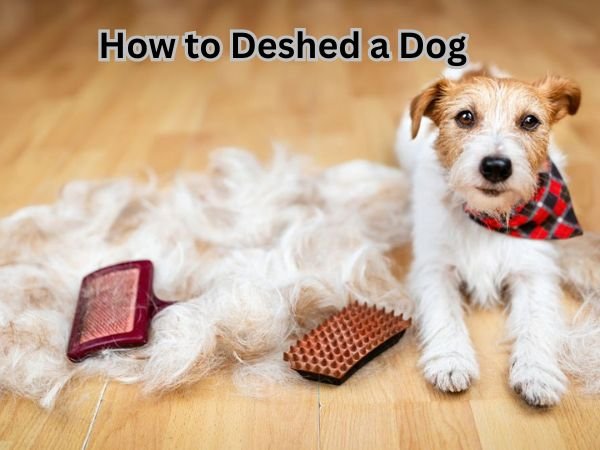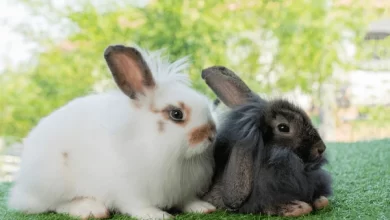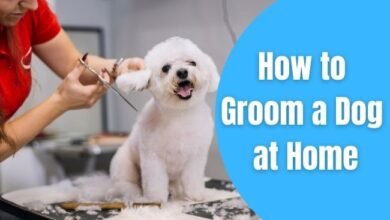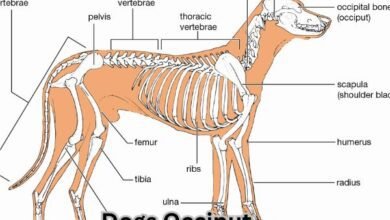
Shedding is a natural part of having a furry friend, but when dog hair seems to take over the house, it’s time to learn how to deshed a dog properly. Deshedding is more than just removing loose fur—it’s a thoughtful grooming process that helps keep your dog’s coat healthy and your home cleaner. Whether your dog sheds seasonally or year-round, regular deshedding prevents mats, reduces allergens, and makes managing pet hair less of a chore.
This article will share eight genius tips that make deshedding easier and more effective, so both you and your pup can enjoy a tidier, happier home.
What Is Deshedding and Why Is It Important?
Deshedding isn’t just your regular daily brushing routine – it’s a specialized grooming technique that targets your dog’s undercoat to remove loose, dead hair before it ends up all over your furniture. Think of it as deep cleaning for your pup’s coat!
How Deshedding Differs From Regular Brushing
While regular brushing smooths the top layer of fur and prevents tangles, deshedding goes deeper. It specifically targets:
- Undercoat removal – Gets to the fluffy layer beneath the topcoat
- Dead hair extraction – Pulls out fur that’s ready to fall out naturally
- Deep cleaning – Reaches areas regular brushes can’t access
Regular brushing is like tidying up your living room, while deshedding is like doing a thorough spring cleaning!
Key Benefits of Deshedding Your Dog
Reduces Loose Fur Around the House
Say goodbye to those tumbleweeds of dog hair rolling across your floors. Deshedding can reduce household dog shedding by up to 90% when done regularly.
Improves Your Dog’s Skin Health
- Better air circulation to the skin
- Prevents matting that can cause skin irritation
- Reduces risk of hot spots and bacterial growth
- Allows natural oils to distribute evenly
Maintains a Shiny, Healthy Coat
When you remove loose dog hair effectively, the remaining coat looks fuller and shinier. Your dog will feel more comfortable too – imagine wearing a thick sweater in summer versus a breathable shirt!
Why It Matters for You and Your Pet
Deshedding isn’t just about keeping your home cleaner (though that’s a nice bonus). It’s about your dog’s comfort and health. Dogs with less loose fur trapped in their coat stay cooler, scratch less, and feel happier overall.
The best part? Once you establish a routine to reduce dog fur at home through proper deshedding, you’ll spend less time vacuuming and more time enjoying cuddles with your four-legged friend.
8 Genius Tips on How to Deshed a Dog
1.Brush Your Dog Regularly with the Right Tools
Regular brushing is your best friend when it comes to managing your dog’s shedding. Think of it as a simple daily habit that makes a huge difference – like brushing your own teeth!
Choose the Right Brush for Your Dog’s Coat
Not all brushes work the same way. Here’s what works best:
For Short-Haired Dogs:
- Rubber curry brushes
- Bristle brushes
- De-shedding tools like FURminator
For Long-Haired Dogs:
- Pin brushes
- Slicker brushes
- Metal combs for tangles
For Double-Coated Breeds:
- Undercoat rakes
- De-shedding tools
- Pin brushes for the top coat
Make Brushing a Pleasant Experience
Your dog should love brush time, not dread it. Here’s how:
- Start with short 5-minute sessions
- Give treats and praise throughout
- Be gentle – no tugging or pulling
- Let your dog sniff the brush first
- Pick a quiet, comfortable spot
How Often Should You Brush?
Daily brushing works best for most dogs, especially during shedding seasons (spring and fall). Even just 10 minutes a day can cut loose hair by 90%.
Why Dead Hair Falls Off Naturally
Your dog’s coat goes through a natural cycle. Old, dead hair loosens from the skin and eventually falls out on its own. This is completely normal! However, when you don’t help remove this loose hair, it ends up all over your furniture, clothes, and floors.
How Brushing Removes Dead Hair
The Simple Science Behind It
When you brush your dog, you’re essentially doing what nature would do anyway – but in a controlled way. Here’s what happens:
- The brush catches loose hair before it has a chance to fall off naturally
- Gentle pulling action removes hair that’s already detached from the follicle
- No harm to healthy hair since you’re only removing what’s ready to come out
Imagine your dog’s coat is like a tree in autumn. The dead leaves (hair) are going to fall eventually – brushing just helps them come off in your brush instead of on your couch!
The Benefits of Proactive Brushing
- Less mess around your home
- Reduced allergens in the air
- Healthier skin for your dog
- Better air circulation through their coat
- Quality bonding time with your pet
Regular brushing turns shedding from a messy problem into a manageable routine that benefits both you and your furry friend.
2.Bathe Your Dog with Deshedding Shampoo and Conditioner
Taking care of your furry friend’s shedding doesn’t have to be a constant battle. The right bath products can make a huge difference in managing loose fur before it ends up all over your furniture.
Why Special Shampoo Makes a Difference
Regular dog shampoo cleans your pup, but deshedding formulas do much more. These products are specially made to:
- Loosen stubborn dead hair that’s ready to fall out anyway
- Nourish the skin underneath all that fur
- Strengthen healthy hair so it stays put longer
- Reduce future shedding by keeping follicles healthy
The Magic of Deshedding Conditioner
Think of conditioner as the secret weapon in your anti-shed arsenal. Here’s what it does:
- Softens the coat making brushing easier later
- Adds moisture to prevent dry, flaky skin
- Creates a protective barrier around each hair strand
- Makes loose fur slip out easily during the bath
Getting the Best Results
For maximum effectiveness, massage the shampoo gently into your dog’s coat and let it sit for 2-3 minutes. Follow up with conditioner, focusing on areas that shed the most. You’ll be amazed at how much loose fur rinses away, leaving your dog’s coat healthier and your home cleaner.
The investment in quality deshedding products pays off quickly when you’re not constantly vacuuming pet hair from every surface in your house!
3.Brush Your Dog After a Bath for Easier Hair Removal
Timing is everything when it comes to removing loose fur from your furry friend. Bathing your dog first might seem backwards, but it’s actually one of the smartest moves you can make.
Why Post-Bath Brushing Works So Well
When your dog gets wet, something magical happens to their coat. The water loosens up all that stubborn dead hair that’s been clinging on for dear life. Think of it like washing dishes – everything comes off easier when it’s been soaked first.
The Perfect Post-Bath Routine
Here’s your simple step-by-step process:
- Towel dry gently – Pat, don’t rub aggressively
- Wait for damp, not soaking – The coat should be moist but not dripping
- Start brushing immediately – Don’t wait for complete drying
- Use long, gentle strokes – Let the brush do the work
- Work section by section – Don’t rush through it
Pro Tips for Success
- Choose the right brush: A slicker brush or undercoat rake works best on damp fur. The wet hair slides off the brush more easily than when it’s bone dry.
- Be patient: Your dog might be a little squirmy after their bath, so take breaks if needed. Make it a positive experience with treats and praise.
- Expect amazing results: You’ll be shocked at how much more hair comes out compared to dry brushing. It’s like the difference between sweeping dry leaves versus wet ones – everything just flows better.
4.Use a High-Velocity Dog Dryer to Blow Away Loose Fur
A high-velocity dryer is one of the best tools for removing loose fur from your dog’s coat. Think of it as a powerful hair dryer designed specifically for pets. It works by blowing air at high speed to push out dead hair before it falls around your home.
Why High-Velocity Dryers Work So Well
These dryers are incredibly effective because they:
- Reach deep into the coat – The strong airflow penetrates through multiple layers of fur
- Remove loose hair efficiently – They blow out fur that’s ready to shed anyway
- Work on all coat types – From short-haired breeds to thick double coats
- Save time – Much faster than brushing alone
How to Use a High-Velocity Dryer Safely
Before You Start
- Choose a quiet area where your dog feels comfortable
- Let your dog get used to the sound first by running it nearby
- Have treats ready to keep your pup calm and happy
The Drying Process
- Start on low speed – Begin with the gentlest setting to help your dog adjust
- Keep the nozzle moving – Never stay in one spot too long to avoid irritating the skin
- Work in sections – Start from the back and work your way forward
- Watch your dog’s comfort level – Take breaks if they seem stressed
Pro Tips for Best Results
- Use after a bath – Wet fur releases loose hair more easily
- Work outdoors if possible – The fur will blow away instead of coating your furniture
- Be patient – Some dogs need time to get comfortable with the noise and sensation
Remember, your dog’s comfort comes first. If they’re too anxious, try shorter sessions and gradually build up their tolerance. With practice, most dogs learn to enjoy this grooming routine!
5.Maintain a Regular Grooming Schedule
Creating a consistent grooming routine is the cornerstone of effective deshedding. Think of it like brushing your own hair – the more regularly you do it, the easier it becomes.
Why Regular Grooming Works:
- Prevents loose fur from building up in your dog’s coat
- Reduces the amount of hair floating around your home
- Keeps your dog’s skin healthy and well-ventilated
- Makes each grooming session shorter and more pleasant
Setting Up Your Schedule:
Daily Brushing (5-10 minutes)
- Best for heavy shedders like Golden Retrievers or German Shepherds
- Quick brush-through prevents mats and tangles
- Perfect bonding time with your pup
Every Other Day
- Ideal for moderate shedders
- Catches loose fur before it hits your furniture
- Manageable for busy pet parents
Weekly Sessions
- Works for light shedders or short-haired breeds
- Include a thorough brush-out and quick health check
- Great maintenance routine
Pro Tips for Success:
- Pick the same time each day – dogs love routine
- Start with short 2-3 minute sessions if your dog is new to grooming
- Always reward with treats and praise
- Use this time to check for any skin issues or unusual lumps
Remember, consistency beats perfection. Even a quick daily brush is better than an hour-long struggle once a week. Your dog will learn to enjoy the attention, and you’ll love having less fur on everything you own!
6.Consider Professional Deshedding Treatments or Groomers
Sometimes, even with your best efforts at home, your furry friend might need extra help. That’s where professional groomers come in handy.
When to Call the Pros
Heavy shedding seasons can be overwhelming. Spring and fall often bring intense shedding that regular brushing can’t handle. Professional groomers have special tools and techniques that make a huge difference.
Double-coated breeds like Golden Retrievers, German Shepherds, and Huskies benefit most from professional deshedding. These dogs have thick undercoats that are tricky to manage without proper equipment.
What Professional Services Offer
- High-velocity blow dryers that remove loose fur from deep within the coat
- Professional-grade deshedding tools not available to regular pet owners
- Specialized shampoos and conditioners that help loosen dead hair
- Expert technique for thorough yet gentle deshedding
Deshedding Treatment Benefits
Professional treatments can reduce shedding by 80-90% for several weeks. Your groomer will:
- Remove the undercoat safely without damaging the top coat
- Use techniques that prevent matting and skin irritation
- Apply conditioning treatments that keep the remaining coat healthy
- Give you maintenance tips for between visits
Cost vs. Convenience
While professional deshedding costs more than DIY methods, many pet owners find it worthwhile. You’ll save time on daily cleanup and enjoy a cleaner home for weeks.
Pro tip: Schedule deshedding treatments before peak shedding seasons for best results.
7.Use Absorber Towels to Remove Excess Water and Loose Hair
After bath time, your furry friend is probably dripping wet and ready to shake water everywhere! This is where super-absorbent towels become your best friend in the deshedding process.
Why Absorber Towels Work So Well
Regular towels just don’t cut it when dealing with a wet, shedding dog. Absorber towels are specially designed to:
- Soak up more water faster – They hold 5-10 times more liquid than regular towels
- Trap loose fur – The microfiber material catches shed hair that’s ready to fall out
- Reduce drying time – Less time spent drying means less stress for your pup
How to Use Them Effectively
Start with gentle pressure:
- Pat and press the towel against your dog’s coat rather than rubbing vigorously
- Work from head to tail in the direction of hair growth
- Pay extra attention to areas that hold the most water (chest, legs, and belly)
Use the wrap-and-squeeze method:
- Wrap sections of your dog’s coat in the towel
- Gently squeeze to absorb water and capture loose hair
- This technique is especially helpful for long-haired breeds
Pro Tips for Best Results
- Have multiple towels ready – You’ll likely need 2-3 for larger dogs
- Check the towel frequently – You’ll be amazed at how much hair gets trapped
- Be patient – Let your dog shake naturally between toweling sessions
The bonus? Your dog will feel more comfortable, and you’ll have less wet dog smell lingering in your home. Plus, all that loose hair ends up in the towel instead of on your furniture!
8.Feed a Healthy Diet to Promote a Strong Coat
A good diet is your secret weapon against excessive shedding. What goes into your dog’s bowl directly affects what comes off their coat.
The Foundation: High-Quality Protein
Your dog’s coat is made of protein, so they need plenty of it to grow strong, healthy fur that stays put. Look for dog foods where real meat is the first ingredient.
Essential Nutrients for Less Shedding
- Omega-3 fatty acids – Found in fish oil, these make coats shiny and reduce loose hair
- Omega-6 fatty acids – Help keep skin moisturized and healthy
- Vitamin E – Acts as a natural antioxidant for skin health
- Zinc – Prevents dry, flaky skin that leads to more shedding
Simple Diet Tips That Work
- Choose foods with salmon, chicken, or other whole proteins
- Avoid fillers like corn and wheat that offer little nutrition
- Make sure your dog drinks plenty of fresh water daily
- Stick to one food brand – frequent switching can stress their system
When to Consider Supplements
If your dog eats quality food but still sheds heavily, talk to your vet about:
- Fish oil capsules
- Coconut oil (start with small amounts)
- Specialized coat supplements
Remember, dietary changes take 6-8 weeks to show results in your dog’s coat. Be patient and consistent for the best outcome.
Conclusion
Deshedding your dog doesn’t have to be overwhelming. With the right approach and tools, you can make it a positive experience for both you and your furry friend.
Key Takeaways
- Regular brushing is your best defense against excessive shedding
- Choose the right tools for your dog’s specific coat type
- Proper nutrition and hydration support healthy coat growth
- Professional grooming can complement your at-home efforts
- Patience and consistency lead to the best results
Benefits You’ll Notice
- Less fur on your furniture and clothes
- Reduced allergens in your home
- Stronger bond with your dog through grooming sessions
- Healthier, shinier coat for your pet
- Earlier detection of skin issues or parasites
Your Next Steps
Start implementing these deshedding techniques today. Begin with short, gentle sessions to help your dog get comfortable with the process. Remember, consistency beats intensity every time.
Try these tips for the next two weeks and see the difference! Take before and after photos of your home and your dog’s coat. Share your results with other pet parents – you might inspire them to start their own deshedding routine.
FAQ
What is the best way to deshed a dog?
The best way to deshed a dog is by using a deshedding brush or grooming tool made for their coat type. Regular brushing, bathing with de-shedding shampoo, and keeping your dog’s diet healthy also help reduce loose hair at home.
How often should I deshed my dog?
You should deshed your dog at least once or twice a week. During heavy shedding seasons, like spring and fall, brushing daily helps remove loose fur, prevents mats, and keeps your home cleaner. Regular grooming keeps your dog’s coat healthy
Does bathing help reduce dog shedding?
Yes, bathing with a gentle deshedding shampoo helps loosen dead hair and reduces shedding. Always rinse well to avoid skin irritation. After the bath, brush your dog to remove extra fur. A regular bath routine can control shedding and improve coat health.
What tools are best for deshedding dogs?
The best deshedding tools include slicker brushes, undercoat rakes, and grooming gloves. Choose a tool that matches your dog’s coat type. For heavy shedders, a deshedding brush works best. These tools remove loose hair, reduce shedding, and keep your dog’s coat smooth.
Can diet affect how much my dog sheds?
Yes, diet plays a big role in dog shedding. A balanced diet rich in omega-3 and omega-6 fatty acids supports healthy skin and coat. Poor nutrition can lead to dry skin and more shedding. High-quality food helps reduce loose fur naturally.



